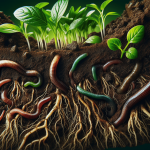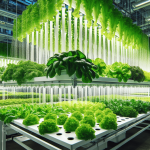This post may contain affiliate links. As an Amazon Associate, we may earn commissions from qualifying purchases.
In the fascinating world of botany, polyploidy stands out as a remarkable phenomenon where plants hold more than two sets of chromosomes. This captivating feature can influence plant growth and enhance fruit production in extraordinary ways. By delving into the mechanisms behind polyploidy and examining its benefits, you gain a deeper appreciation for the natural complexities that drive successful cultivation and bountiful harvests. Whether you’re an avid gardener or simply curious about plant biology, understanding polyploidy opens up a world of possibilities for optimizing plant health and yield. Are you curious about how some plants seem to grow faster, look bigger, or produce more fruits than others? Well, one fascinating explanation lies in the phenomenon known as polyploidy. In this article, you’ll embark on a journey to explore the intricate world of polyploidy in plants and unravel its impact on growth and fruit production. By the end of our exploration, you’ll have a richer understanding of how this unique genetic trait can enhance agricultural practices and potentially improve your own gardening skills.
What is Polyploidy?
Polyploidy is a condition in which a plant has more than two complete sets of chromosomes. While humans and most other animals are diploid—meaning they have two sets of chromosomes—many plants are polyploid. This genetic trait can arise naturally or be induced artificially for various agricultural benefits.
Types of Polyploidy
To better understand polyploidy, it’s helpful to be aware of its types. There are several types of polyploidy, each with unique characteristics and implications for plant growth and fruit production.
- Autopolyploidy: This occurs when all sets of chromosomes originate from the same species. Essentially, the plant duplicates its own chromosome set.
- Allopolyploidy: In this case, the chromosome sets come from different species, resulting from hybridization followed by chromosome doubling.
- Endopolyploidy: This involves only certain cells in a tissue becoming polyploid, while the rest remain diploid.
Here’s a straightforward table summarizing these types:
| Type | Origin |
|---|---|
| Autopolyploidy | Chromosome sets from the same species |
| Allopolyploidy | Chromosome sets from different species |
| Endopolyploidy | Partial tissues within the plant become polyploid |
Understanding these distinctions sets the stage for grasping how polyploidy influences plant characteristics and behaviors.
Mechanisms Behind Polyploidy Formation
Polyploidy can form via various mechanisms, both natural and artificial. Let’s delve into these mechanisms to see how plants end up with extra chromosome sets.
Natural Mechanisms
Natural occurrences of polyploidy often result from errors during cell division. Here are the key processes:
- Nondisjunction: During cell division, chromosomes fail to separate properly, leading to gametes with extra chromosomes.
- Somatic Doubling: A cell within the plant undergoes chromosome duplication without dividing, creating polyploid cells.
- Hybridization: Cross-breeding between different species can result in the fusion of distinct chromosome sets, followed by natural doubling.
Artificial Induction
Humans have also developed techniques to artificially induce polyploidy, primarily for agricultural benefits. Some of these methods include:
- Chemical Treatment: Substances like colchicine interrupt the normal division of cells, causing chromosome doubling.
- Physical Techniques: Shock treatments—like temperature changes—can also induce polyploidy.
Consequences of Polyploidy Induction
Inducing polyploidy can result in immediate benefits such as increased cell size and genetic diversity. However, it can also introduce challenges like sterility or developmental delays. It’s a delicate balancing act that requires careful consideration.

Impact on Plant Growth
One of the most exciting aspects of polyploidy is its impact on plant growth. Increased chromosome number often translates into tangible growth benefits.
Enhanced Cell Size
Polyploid cells are generally larger than diploid cells. This size increase can result in bigger leaves, stems, and roots, ultimately contributing to more robust plant growth.
Increased Vigor
Polyploidy often brings about what is called “hybrid vigor” or heterosis. Plants may show enhanced growth rates, greater resistance to diseases, and better adaptation to environmental stresses.
Growth Regulation
While polyploidy can enhance growth, it also comes with regulatory challenges. Some polyploid plants may face growth delays, and fluctuations in growth rates are common. Regulatory genes within the plant often need time to adjust to the new chromosome sets.
Impact on Fruit Production
Now to the part many of you may find the most exciting: fruit production. Understanding how polyploidy affects fruit size, yield, and quality can revolutionize agricultural practices and backyard gardening alike.
Larger Fruits
Polyploid plants often produce larger fruits compared to their diploid relatives. This size increase is generally due to the enlargement of individual cells.
Improved Flavor and Nutritional Content
In some cases, polyploidy can positively impact the flavor and nutritional content of fruits. Increased genetic material can lead to higher concentrations of sugars, vitamins, and other beneficial compounds.
Greater Yield
Polyploid plants usually have a higher yield, producing more fruits per plant. This characteristic is beneficial in agricultural settings where maximizing output is crucial.

Practical Applications in Agriculture
The implications of polyploidy extend far beyond theoretical knowledge; they have practical applications that can revolutionize agriculture.
Crop Improvement
Introducing polyploid varieties of crops can solve many challenges farmers face, from increasing yields to improving resistance against diseases and pests.
Case Studies
-
Strawberries: Most commercial strawberries are octoploid, having eight sets of chromosomes. These strawberries are larger, juicier, and more delicious than their diploid ancestors.
-
Wheat: Modern bread wheat is hexaploid, with six sets of chromosomes. This complexity provides the adaptability necessary for varying agricultural conditions and results in the high yields essential for food security.
Future Prospects
Future advances could include creating more polyploid varieties that are optimized for different environments or nutritional needs, opening up new possibilities for food production.
Challenges and Limitations
However, it’s not all rosy. Polyploidy also comes with a set of challenges and limitations that need to be addressed for its effective utilization in agriculture.
Genetic Instability
Polyploid plants can sometimes exhibit genetic instability, leading to abnormalities that can impact growth and yield.
Sterility
Some polyploid plants can be sterile, which poses challenges for breeding programs.
Environmental Sensitivity
These plants may also exhibit increased sensitivity to environmental changes, necessitating more precise agricultural practices.
Conclusion
Exploring polyploidy in plants reveals a fascinating layer of complexity that significantly impacts growth and fruit production. While the natural world offers countless examples of polyploidy, the ability to induce this condition artificially opens up vast possibilities for agricultural innovation. From larger fruits to enhanced resistance against diseases, the benefits are immense. Yet, it’s crucial to manage the associated challenges to fully harness this genetic trait.
So, whether you’re a seasoned gardener, an agricultural professional, or simply someone with a green thumb, understanding polyploidy offers an exciting glimpse into the future of plant growth and fruit production.
Feel free to dive deeper into this intriguing subject, and who knows? You may even consider applying these insights to your next gardening project, reaping the benefits of polyploidy in your own backyard. Happy growing!








